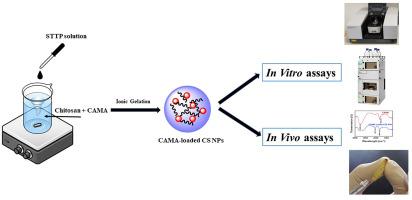Chitosan nano-encapsulation enhances targeted delivery of cecropin-A (1–7)-Melittin peptide to combat intracellular multi-drug-resistant non-typhoidal Salmonella
IF 4.9
3区 医学
Q1 PHARMACOLOGY & PHARMACY
Journal of Drug Delivery Science and Technology
Pub Date : 2025-09-02
DOI:10.1016/j.jddst.2025.107478
引用次数: 0
Abstract
This study aimed to encapsulate the Cecropin A (1–7)–Melittin (CAMA) peptide within chitosan nanoparticles (CS NPs) and evaluate its antimicrobial activity against multi-drug-resistant (MDR) strains of non-typhoidal Salmonella, employing both in vitro and in vivo assays. The CAMA-loaded CS NPs, synthesized using the ionic gelation technique, exhibited a particle size of 219.31 ± 38.24 nm and a zeta potential of 8.2 ± 0.2 mV, as measured by dynamic light scattering. The encapsulation efficiency was 75.45 ± 2.5 %. Additionally, Fourier-transform infrared spectroscopy, scanning electron microscopy and transmission electron microscopy determined the functional groups, morphology and size of the CAMA-loaded CS NPs. The in vitro release kinetics revealed a pH-dependent release profile, with the highest cumulative release observed within 24 h at an alkaline pH (8.20), followed by physiological pH (7.40). Intracellular antimicrobial efficacy was assessed using HEp-2 cell lines, where CAMA-loaded CS NPs effectively cleared intracellular MDR Salmonella strains. Furthermore, CAMA-loaded CS NPs were found to be safe for use with sheep erythrocytes, HEp-2 and RAW 264.7 cell lines, and beneficial gut lactobacilli, and were stable in the presence of proteolytic enzymes and simulated biological fluids. In vivo assays in Galleria mellonella larvae demonstrated an improved survival rate, reduced bacterial count, and minimal cytotoxicity, as confirmed by the lactate dehydrogenase assay. These results correlated with histopathological examination, suggesting that CAMA-loaded CS NPs could be a promising therapeutic candidate for combating intracellular Salmonella.

壳聚糖纳米包封增强抗菌肽a(1-7)-蜂毒肽靶向递送对抗细胞内多重耐药非伤寒沙门氏菌
本研究旨在将Cecropin A (1-7) -Melittin (CAMA)肽包封在壳聚糖纳米颗粒(CS NPs)内,并通过体外和体内试验评价其对非伤寒沙门氏菌多重耐药(MDR)菌株的抑菌活性。采用离子凝胶技术合成的cama负载的CS NPs,其粒径为219.31±38.24 nm, zeta电位为8.2±0.2 mV。包封率为75.45±2.5%。此外,傅里叶变换红外光谱、扫描电镜和透射电镜测定了cama负载的CS NPs的官能团、形态和尺寸。体外释放动力学显示出pH依赖的释放曲线,在碱性pH(8.20)下24 h内的累积释放最高,其次是生理pH(7.40)。使用HEp-2细胞系评估细胞内抗菌效果,其中负载cama的CS NPs有效清除细胞内耐多药沙门氏菌菌株。此外,cama负载的CS NPs在绵羊红细胞、HEp-2和RAW 264.7细胞系以及有益的肠道乳酸菌中使用是安全的,并且在蛋白水解酶和模拟生物液体存在下是稳定的。通过乳酸脱氢酶试验证实,在mellonella幼虫体内试验表明,提高了存活率,减少了细菌数量,并且最小的细胞毒性。这些结果与组织病理学检查相关,表明负载cama的CS NPs可能是对抗细胞内沙门氏菌的有希望的治疗候选物。
本文章由计算机程序翻译,如有差异,请以英文原文为准。
求助全文
约1分钟内获得全文
求助全文
来源期刊
CiteScore
8.00
自引率
8.00%
发文量
879
审稿时长
94 days
期刊介绍:
The Journal of Drug Delivery Science and Technology is an international journal devoted to drug delivery and pharmaceutical technology. The journal covers all innovative aspects of all pharmaceutical dosage forms and the most advanced research on controlled release, bioavailability and drug absorption, nanomedicines, gene delivery, tissue engineering, etc. Hot topics, related to manufacturing processes and quality control, are also welcomed.

 求助内容:
求助内容: 应助结果提醒方式:
应助结果提醒方式:


